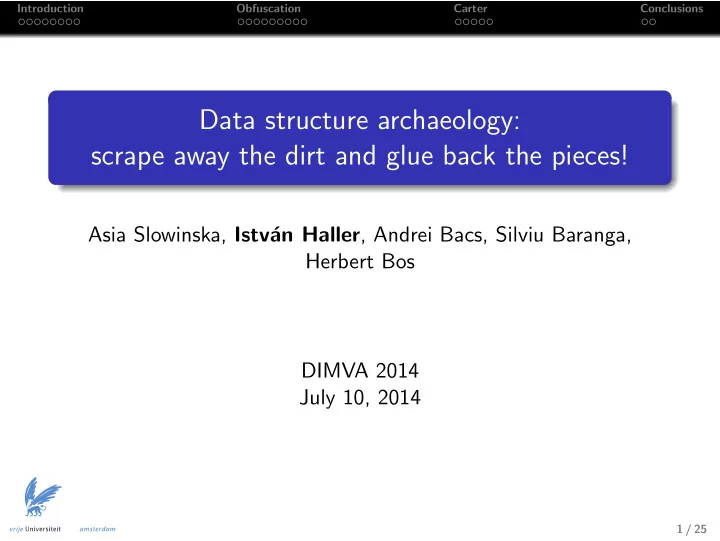

Introduction Obfuscation Carter Conclusions Data structure archaeology: scrape away the dirt and glue back the pieces! Asia Slowinska, Istv´ an Haller , Andrei Bacs, Silviu Baranga, Herbert Bos DIMVA 2014 July 10, 2014 1 / 25
Introduction Obfuscation Carter Conclusions Significant research on control-flow obfuscation 2 / 25
Introduction Obfuscation Carter Conclusions But what about the data? 3 / 25
Introduction Obfuscation Carter Conclusions Program data valuable for reverse engineering Recent work on data structure reversing Data layout left intact by control obfuscation Howard (NDSS’11), TIE (NDSS’11) Obfuscation resilient code extraction The underlying data-flow is typically unchanged Trace-oriented programming (CCS’13) Compiler techniques could eliminate unnecessary code 4 / 25
Introduction Obfuscation Carter Conclusions Available data-obfuscation strategies Variable Splitting Split variable content across multiple locations Locations may be reordered or interleaved Memory dumps contain garbled data Used in commercial obfuscation products 5 / 25
Introduction Obfuscation Carter Conclusions Available data-obfuscation strategies Variable Merging Share memory location by multiple variables Typically combined with splitting 6 / 25
Introduction Obfuscation Carter Conclusions Research questions Are the currently suggested data obfuscation techniques viable against a determined attacker? Are there fundamental properties of data-flows which make attempts at obfuscation futile? 7 / 25
Introduction Obfuscation Carter Conclusions Research questions Are the currently suggested data obfuscation techniques viable against a determined attacker? NO! ⌢ � ¨ Are there fundamental properties of data-flows which make attempts at obfuscation futile? Does not seem like it! ⌣ � ¨ 8 / 25
Introduction Obfuscation Carter Conclusions Approach Carter data deobfuscation tool against split/merge obfuscation Leverages inherent properties of the obfuscation Based on program access patterns and information flow Focus : split obfuscation 9 / 25
Introduction Obfuscation Carter Conclusions Split obfuscation 10 / 25
Introduction Obfuscation Carter Conclusions Split obfuscation 11 / 25
Introduction Obfuscation Carter Conclusions Split obfuscation 12 / 25
Introduction Obfuscation Carter Conclusions Split obfuscation 13 / 25
Introduction Obfuscation Carter Conclusions Split obfuscation 14 / 25
Introduction Obfuscation Carter Conclusions Example of split obfuscation Representation: Upper K-1 bits and Lowest bit Encoding: X 1 = X / 2 and X 2 = X mod 2 Decoding: X = X 1 ∗ 2 + X 2 Mapping for addition ( Z = X + Y ) Z 1 = X 1 + Y 1 + ( X 2 + Y 2) / 2 Z 2 = ( X 2 + Y 2) mod 2 15 / 25
Introduction Obfuscation Carter Conclusions Properties of the obfuscation P1: Access to the variable is synchronized The sub-components are always accessed together The accesses are grouped together in time 16 / 25
Introduction Obfuscation Carter Conclusions Properties of the obfuscation P2: The variable must be decoded when interacting externally External library calls and pointer dereferences cannot use obfuscated value (system unaware of obfuscation) Decoding involves a merger of the individual data-flows 17 / 25
Introduction Obfuscation Carter Conclusions Potential corner-cases Compilers encoding 64-bit values in 32-bit binaries The two 32-bit components act as split components The components are accessed together and share data-flows Unavoidable false-positives (small percentage in practice) Some variable pairs may be used synchronously For example: array+length, elements of a struct The lack of decoding can filter false positives In most cases the data-flows never merge, thus the candidate is not confirmed to be a split variable 18 / 25
Introduction Obfuscation Carter Conclusions Carter - Setup Use memory access trace to detect access groups (P1) Groups of variables accessed together within a short time-frame Based on reference affinity grouping (cache optimization) Uses information-flow tracking to confirm candidates (P2) Each entry in a group receives its own tag Tags are propagated along data-flow Carter checks if tags are ever combined 19 / 25
Introduction Obfuscation Carter Conclusions Reference affinity grouping Traditionally used to maximize cache-line reuse Generates variable partitions where accesses are optimal Carter is searching variable groups always accessed together 20 / 25
Introduction Obfuscation Carter Conclusions Evaluation - Basic split detection TPs Partially correct FPs FNs base64 79% 21% 0% 0% expr 100% 0% 0% 0% factor 58% 42% 1.84% 0% ls 94% 6% 0.41% 0% grep 88% 11% 0.82% 1% gzip 93% 0% 0% 7% lighttpd 97% 3% 0% 0% wget 84% 12% 0.76% 4% Table: Results for deobfuscation of split variables. 21 / 25
Introduction Obfuscation Carter Conclusions Impact of control obfuscation Dynamic analysis ensures proper data-flow tracking Extra instructions may affect memory trace Can be simulated by injecting spurious memory accesses 22 / 25
Introduction Obfuscation Carter Conclusions Evaluation - Combined with control obfuscation TPs Partially correct FPs FNs base64 72% 20% 0% 8% expr 82% 0% 0% 18% factor 56% 39% 1.84% 5% ls 79% 12% 0.83% 9% grep 72% 16% 0.68% 12% gzip 100% 0% 0% 0% lighttpd 94% 2% 0% 4% wget 78% 10% 0.57% 12% Table: Results for deobfuscation with 4 spurious accesses. 23 / 25
Introduction Obfuscation Carter Conclusions Impact on future data obfuscation approaches Data obfuscation still in its infancy More sophisticated approaches necessary in the future Static placement of variables is subject to temporal analysis Suggestion: aggressive memory reuse Additionally: disrupt data-flow tracking 24 / 25
Introduction Obfuscation Carter Conclusions Conclusions Carter is a new deobfuscation tool, against the split and split+merge data obfuscation techniques Existing techniques vulnerable against determined attackers New research avenues to break the assumptions of Carter 25 / 25
Recommend
More recommend